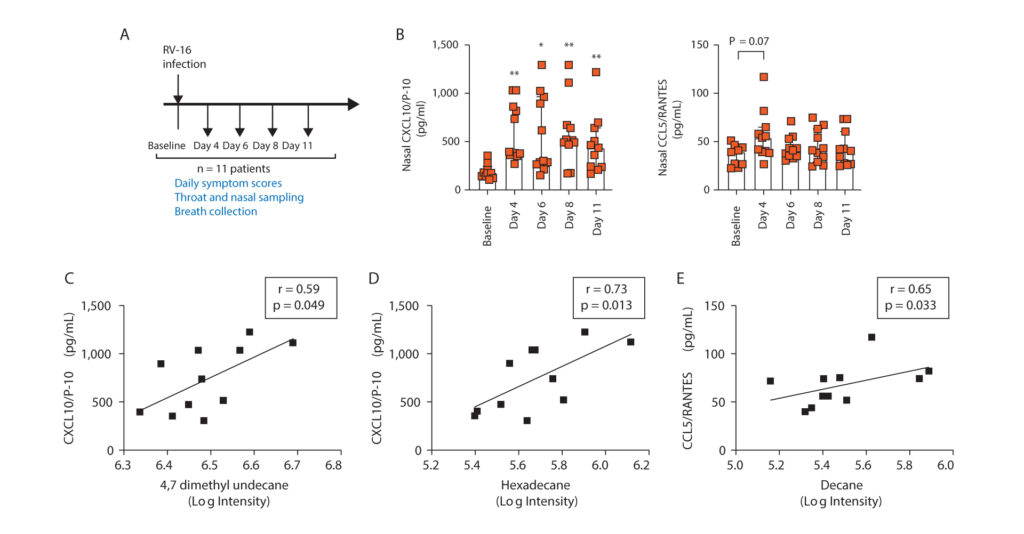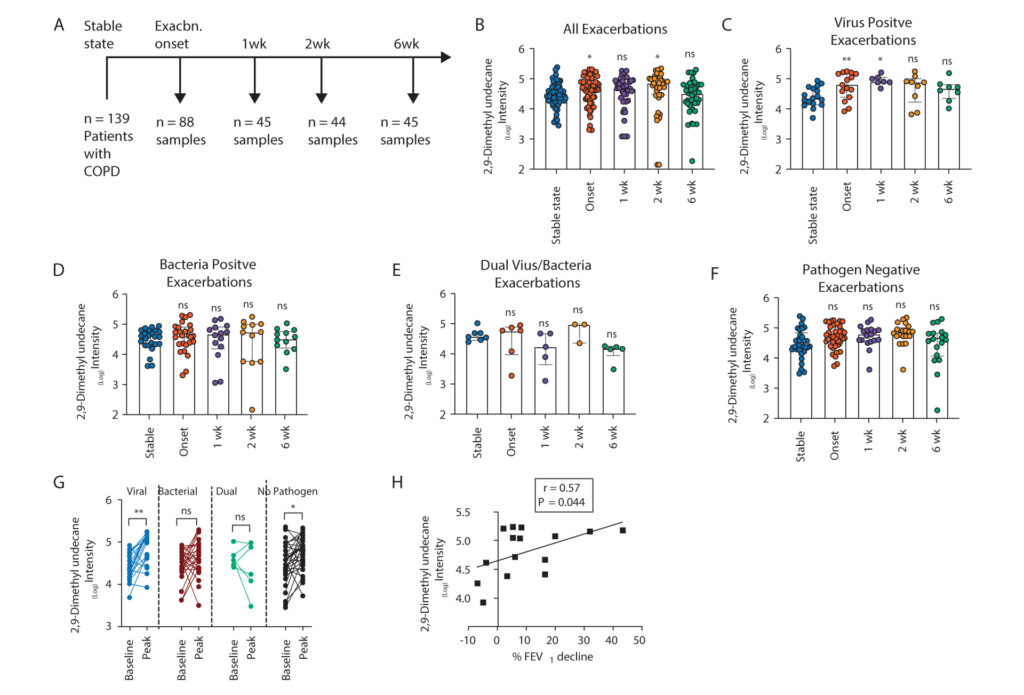Breath Analysis for Diagnosing Viral Infections in COPD
This study showcases how breath analysis, utilizing TD-GC-MS, identifies specific volatile organic compounds (VOCs) like decane and long-chain alkane compounds in the breath of COPD patients with viral infections, offering potential biomarkers for tailored treatment approaches.
| Publication Information: Kamal F, Kumar S, Edwards MR, Veselkov K, Belluomo I, Kebadze T, Romano A, Trujillo-Torralbo MB, Shahridan Faiez T, Walton R, Ritchie AI, Wiseman DJ, Laponogov I, Donaldson G, Wedzicha JA, Johnston SL, Singanayagam A, Hanna GB. Virus-induced Volatile Organic Compounds Are Detectable in Exhaled Breath during Pulmonary Infection. Am J Respir Crit Care Med. 2021 Nov 1;204(9):1075-1085. doi: 10.1164/rccm.202103-0660OC.
Disease Area: Infectious Disease Application: Breath analysis is used to detect viral infections in COPD patients by identifying specific volatile organic compounds (VOCs) associated with these infections. Sample medium: Breath Analysis approach: TD-GC-MS Summary: The study highlights the release of specific VOCs, such as decane and long-chain alkane compounds, in the breath of individuals with viral respiratory infections, suggesting their potential as biomarkers for diagnosing viral infections and personalized treatment strategies in COPD patients. Further research is needed to validate these findings and understand the mechanisms underlying the production of VOCs during viral infections in order to qualify them as prospective biomarkers. |
Chronic obstructive pulmonary disease (COPD) is a debilitating respiratory condition characterized by persistent airflow limitation and respiratory symptoms. Patients are particularly susceptible to respiratory infections, which can lead to exacerbations and worsen their overall condition. Early identification of exacerbation triggers is important for treating COPD, but currently available tests are slow and imprecise, limited by the requirement for airway sampling. Furthermore, difficulty distinguishing between viral or bacterial infection in COPD has led to an over-prescription of antibiotics, driving selective pressure towards drug-resistant pathogens. Breath analysis could provide a non-invasive and convenient means to address this clinical need.
In their study, Kamal et al, have explored the potential of breath analysis in both in vitro and in vivo contexts, to detect viral infections in COPD patients by identifying specific volatile organic compounds (VOCs) associated with these infections. This case study aims to illustrate the application of breath analysis as a diagnostic tool for viral infections in a patient with COPD.
BEAS-2B airway epithelial cells were infected with Rhinovirus (RV)-A16 and the volatile organic compounds (VOCs) released in the headspace of the cells were analyzed using GC-MS. A total of 14 metabolites were identified that were significantly altered in the headspace of RV-infected cells compared to controls. Further analysis revealed that decane, an alkane hydrocarbon with potential antiviral properties, was among the identified metabolites. Time-course analysis of decane indicated a significant increase in its release 24 hours after RV infection, suggesting a potential role in the host immune response to viral infections. Epithelial cells were also infected with the bacterial species S.pneumoniae and H. influenzae, with 9 compounds identified as being specifically produced by bacterial infection of epithelial cells. Bacterial infection had no effect on levels of decane, suggesting that decane could be specifically representative of viral infection.
Figure 1: Decane is upregulated in the headspace of epithelial cells with viral infection. This is not observed in those infected with bacteria. (A) Cultured BEAS2B BEC were infected with rhinovirus (RV)-A16, Streptococcus pneumoniae, Haemophilus influenzae, or medium control. Decane levels are shown in response to (B) RV, (C)S. pneumoniae, and (D)H. influenzae infection.
The researchers also analyzed exhaled breath samples from healthy subjects experimentally infected with RV-A16. They identified 17 exhaled compounds, 8 of which included decane and other long-chain alkane compounds, that were increased in the exhaled breath of infected subjects. A substantial increase in the levels of decane, 3,8-dimethyl-undecane, 4,7-dimethyl-undecane, dodecane, and hexadecane was noted at the timepoints coinciding with significant elevations in nasal and oral viral loads. This observation provides additional support that these metabolites are responsive to viral infection.
Figure 2: Long-chain alkane compounds including decane correlate with the antiviral immune responses in subjects experimentally infected with rhinovirus (RV). (A) Eleven healthy subjects were experimentally challenged with RV-A16 and sampled at various time points after infection. (B) Nasal lavage concentrations of CXCL10/IP-10 and CCL5/RANTES. The correlation of nasal CXCL10/IP-10 concentrations with levels of (C) 4,7-dimethyl-undecane and (D) hexadecane, (E) The correlation of nasal CCL5/RANTES concentrations with levels of decane.
In addition, the researchers analyzed the exhaled breath samples of COPD patients experiencing exacerbations. They identified the long-chain alkane 2,9-dimethyl-undecane as being increased in breath during virus-associated exacerbations and correlated with exacerbation severity, highlighting its potential as a biomarker for identifying viral infections in COPD patients.
Figure 3: Levels of 2,9-dimethyl-undecane increased in virus-associated COPD exacerbations. (A) 139 patients with COPD were monitored for 18 months. Patients were sampled at a stable state and after onset of acute exacerbation, with a cohort also sampled at 1, 2, and 6 weeks after onset. Exhaled breath was collected, and levels of 2,9-dimethyl-undecane measured using GC-MS. (B) All exacerbation episodes. (C) Episodes associated with positive viral detection. (D) Episodes associated with potentially pathogenic bacteria. (E) Episodes in which viruses and bacteria were both detected. (F) Episodes in which neither viruses nor bacteria were detected. (G) Comparison of baseline and peak concentrations of 2,9-dimethyl-undecane. (H) Correlation between FEV1 decline during exacerbation and 2,9-dimethyl-undecane levels.
This study demonstrates that viral infections trigger the release of volatile organic compounds, such as decane and long-chain alkane compounds, in the breath of individuals with respiratory infections. These VOCs could potentially serve as biomarkers for viral infections and guide targeted therapy in COPD patients by ruling out bacterial infections and reducing the unnecessary use of antibiotics in the clinic. However, the authors acknowledge the technical factors that may affect the reproducibility of exhaled breath testing, emphasizing the need for consistent sampling methods and standardized procedures.
Breath Biopsy® OMNI® is our complete breath volatile metabolite service, providing standardized breath collection and broad analysis, and optimized for reproducible identification and quantification of informative metabolites from exhaled breath. To discuss incorporating Breath Biopsy into your biomarker research workflow get in touch with our team.
Catch up on the presentations from the Breath Biopsy Conference 2024



